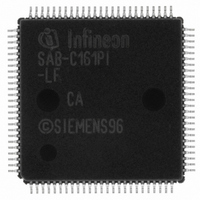SAB-C161PI-LF CA Infineon Technologies, SAB-C161PI-LF CA Datasheet - Page 30

SAB-C161PI-LF CA
Manufacturer Part Number
SAB-C161PI-LF CA
Description
IC MICROCONTROLLER 16BIT 100TQFP
Manufacturer
Infineon Technologies
Series
C16xxr
Datasheet
1.SAF-C161PI-LM_CA.pdf
(82 pages)
Specifications of SAB-C161PI-LF CA
Core Processor
C166
Core Size
16-Bit
Speed
20MHz
Connectivity
EBI/EMI, I²C, SPI, UART/USART
Peripherals
POR, PWM, WDT
Number Of I /o
76
Program Memory Type
ROMless
Ram Size
3K x 8
Voltage - Supply (vcc/vdd)
4.5 V ~ 5.5 V
Data Converters
A/D 4x10b
Oscillator Type
Internal
Operating Temperature
0°C ~ 70°C
Package / Case
100-LFQFP
Packages
PG-TQFP-100
Max Clock Frequency
20.0 MHz
Sram (incl. Cache)
3.0 KByte
A / D Input Lines (incl. Fadc)
4
Program Memory
0.0 KByte
Lead Free Status / RoHS Status
Lead free / RoHS Compliant
Eeprom Size
-
Program Memory Size
-
Other names
B161PILFCAXT
SAB-C161PI-LF CA
SAB-C161PI-LFCAINTR
SABC161PILFCAXT
SP000014344
SAB-C161PI-LF CA
SAB-C161PI-LFCAINTR
SABC161PILFCAXT
SP000014344
&3,
Parallel Ports
The C161PI provides up to 76 IO lines which are organized into six input/output ports
and one input port. All port lines are bit-addressable, and all input/output lines are
individually (bit-wise) programmable as inputs or outputs via direction registers. The I/O
ports are true bidirectional ports which are switched to high impedance state when
configured as inputs. The output drivers of three IO ports can be configured (pin by pin)
for push/pull operation or open-drain operation via control registers. The other IO ports
operate in push/pull mode, except for the I²C interface pins which are open drain pins
only. During the internal reset, all port pins are configured as inputs.
All port lines have programmable alternate input or output functions associated with
them. All port lines that are not used for these alternate functions may be used as general
purpose IO lines.
PORT0 and PORT1 may be used as address and data lines when accessing external
memory, while Port 4 outputs the additional segment address bits A22/19/17...A16 in
systems where segmentation is enabled to access more than 64 KBytes of memory.
Port 3 includes alternate functions of timers, serial interfaces, the optional bus control
signal BHE and the system clock output CLKOUT (or the programmable frequency
output FOUT).
Port 5 is used for the analog input channels to the A/D converter or timer control signals.
Port 6 provides the optional chip select signals and interface lines for the I²C module.
The edge characteristics (transition time) of the C161PI’s port drivers can be selected
via the Port Driver Control Register (PDCR).
Data Sheet
28
1999-07












